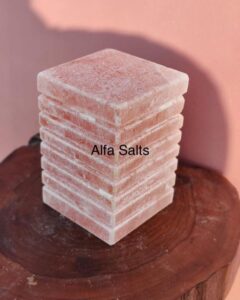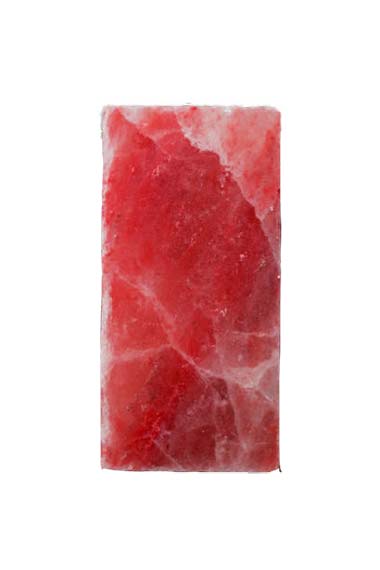Salt tiles, also known as salt blocks or salt bricks, are increasingly gaining popularity in modern times due to their versatile uses and purported health benefits. These tiles are typically made from Himalayan pink salt, which is rich in minerals and trace elements. Here are some common uses and sizes of salt tiles in the modern world:
Cooking and Grilling:
Salt tiles can be used as cooking surfaces for grilling, searing, or serving food. They impart a subtle, salty flavor to the food and can be heated or chilled to various temperatures for different culinary applications. Common sizes for cooking salt tiles range from small (8×4 inches) to large (12×8 inches) rectangles, but custom sizes are also available.

Salt tiles offer a wide range of uses in the modern world, from culinary applications to wellness treatments and decorative accents. The sizes and shapes of salt tiles vary depending on their intended use, with options available to suit different preferences and requirements.
Salt tiles have various uses beyond cooking. Here are some alternative uses along with suitable sizes:
1. Spa and Wellness:
Salt tiles are used in salt therapy rooms, also known as halotherapy rooms, to create a microclimate that mimics natural salt caves. The salt-infused air is believed to have therapeutic benefits for respiratory and skin conditions. For this purpose, salt tiles are often larger in size, typically ranging from 12×12 inches to 24×24 inches, to cover the walls, ceilings, and floors of therapy rooms.
2. Decorative Purposes:
Salt tiles are utilized in interior design for their aesthetic appeal and wellness benefits. They can be arranged on walls, floors, or used as architectural features like salt walls or dividers. For decorative purposes, salt tiles come in various sizes, from small 4×4 inch tiles to larger tiles measuring 12×12 inches or more, depending on the design requirements and space.
3. Salt Therapy:
Salt tiles are used in salt caves or rooms for salt therapy sessions. People sit or lie on the salt tiles while inhaling salt-infused air, which is believed to promote relaxation and alleviate respiratory ailments. Salt therapy tiles are typically larger in size, ranging from 12×12 inches to 24×24 inches, to accommodate seating or lying positions.
4. Illumination:
Salt tiles can be carved into salt lamps or candle holders for decorative lighting purposes. When illuminated, the translucent salt emits a warm, amber glow that creates a soothing atmosphere. Salt tiles used for illumination come in various sizes and shapes, from small
5. Animal Salt Blocks:
Large salt blocks made from compressed salt crystals are used as mineral supplements for livestock. These blocks provide essential minerals like sodium and iodine, promoting animal health and nutrition. Animal salt blocks come in standard sizes suitable for placement in feeding areas or salt licks, typically ranging from 8×8 inches to 12×12 inches.
Salt tiles offer versatility in their applications beyond cooking, providing both functional and aesthetic benefits in various settings such as spas, homes, and agricultural environments. The sizes of salt tiles vary depending on their intended use, with options available to suit different purposes and preferences.
Salt tiles for decoration:
When considering salt tiles for wall decoration, several factors come into play, including the size of the space, the overall aesthetic you wish to achieve, and practical considerations such as installation ease. Here are some considerations along with recommended sizes for wall decoration using salt tiles:
1. Space Size:
Consider the size of the wall or walls you intend to decorate. For smaller spaces or accent walls, smaller salt tiles can work well to create a visually interesting texture without overwhelming the area. Conversely, larger spaces or walls may benefit from larger salt tiles to make a bold statement.
2. Design Intent:
Think about the design aesthetic you want to achieve. If you prefer a more intricate design with smaller details, smaller salt tiles may be preferable. On the other hand, if you want a more minimalist or contemporary look, larger salt tiles with clean lines could be more suitable.
3. Installation Ease:
Larger salt tiles may require fewer individual pieces to cover a wall, which can make installation quicker and easier. However, smaller tiles offer more flexibility in terms of arrangement and can be easier to handle during installation, especially if you’re working with intricate patterns or designs.
4. Visual Impact:
Consider the visual impact you want to achieve with the salt tile wall. Larger tiles can create a bold focal point, while smaller tiles may provide a more subtle, textured effect. Think about how the size of the tiles will complement other elements in the room, such as furniture and decor.
Based on these considerations, here are some recommended salt tile sizes for wall decoration:
Small Tiles:
4×4 inches or 6×6 inches – ideal for creating intricate patterns or adding subtle texture to smaller wall spaces or accent areas.
Medium Tiles:
8×8 inches or 12×12 inches – versatile sizes that work well for both smaller and larger wall spaces, offering a balance between visual impact and ease of installation.
Large Tiles:
12×18 inches or 12×24 inches – suitable for creating bold statements on larger walls or for achieving a more minimalist look with fewer seams.
The best salt tile size for wall decoration will depend on your specific preferences, the size and layout of the space, and the overall design goals you want to achieve. Experimenting with different sizes and arrangements can help you find the perfect balance for your wall decor.
Looking for salt tiles and blocks: Click here




